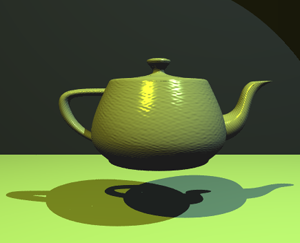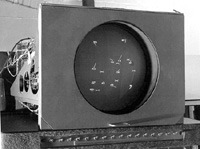Teaching:TUW - UE InfoVis WS 2007/08 - Gruppe 09 - Aufgabe 1 - Computer Graphics: Difference between revisions
Jump to navigation
Jump to search
No edit summary |
No edit summary |
||
| Line 8: | Line 8: | ||
==Subfields== | ==Subfields== | ||
Computer Graphics may be divided into four major categories: | |||
*<b>Geometry</b>: studies ways to represent and process surfaces | *<b>Geometry</b>: studies ways to represent and process surfaces | ||
*<b>Animation</b>: studies with ways to represent and manipulate motion | *<b>Animation</b>: studies with ways to represent and manipulate motion | ||
| Line 13: | Line 15: | ||
*<b>Imaging</b>: studies image acquisition or image editing | *<b>Imaging</b>: studies image acquisition or image editing | ||
[[Image:whirlwind.jpg |thumb|200px|Whirlwind display.]] | |||
==History== | ==History== | ||
Revision as of 23:17, 8 November 2007

Perhaps the best way to define computer graphics is to find out what it is not. It is not a machine. It is not a computer, nor a group of computer programs. It is not the know-how of a graphic designer, a programmer, a writer, a motion picture specialist, or a reproduction specialist.
Computer graphics is all these – a consciously managed and documented technology directed toward communicating information accurately and descriptively.
[Fetter, 1965]
Definition
Computer graphics broadly studies the manipulation of visual and geometric information using computational techniques. Computer graphics as an academic discipline focuses on the mathematical and computational foundations of image generation and processing rather than purely aesthetic issues.
[Wikipedia, 2007]
Subfields
Computer Graphics may be divided into four major categories:
- Geometry: studies ways to represent and process surfaces
- Animation: studies with ways to represent and manipulate motion
- Rendering: studies algorithms to reproduce light transport
- Imaging: studies image acquisition or image editing

History
Application
- graphs and charts
- computer-aided design
- virtual-reality environment
- data visualisation
- education and training
- computer art
- entertainment
- image processing
- graphical user interfaces
References
[Fetter, 1966] W. A. Fetter, Computer Graphics in Communication, McGraw-Hill Book Company, New York, 1965.
[Wikipedia, 2007] Wikipedia, Computer Graphics. Retrieved at: November 8, 2007. http://en.wikipedia.org/wiki/Computer_graphics.